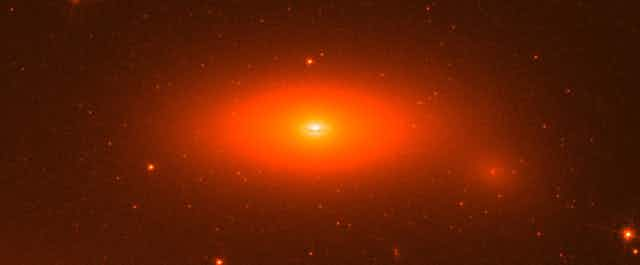Astronomers have discovered a new, enormous black hole that could change our understanding of how galaxies evolve.
Holding the mass of 17 billion suns, the black hole at the centre of the NGC 1277 galaxy may be the largest discovered to date. It is 250 million light-years from the Earth.
Most supermassive black holes are contained within very large galaxies. But the NGC 1277 galaxy is remarkably small compared to the black hole at its centre.
The researchers, who reported their findings in Nature today, say black holes usually take up 0.1% of a galaxy’s “stellar bulge” (the collection of stars at its centre). It’s thought this black hole comprises 59% of its galaxy’s stellar bulge mass, and 14% of the galaxy’s mass overall.

For this reason, the black hole has been described as “overmassive” rather than simply supermassive.
In its entirety, it is thought to be 11 times wider than Neptune’s orbit of the sun.
“This is a really oddball galaxy,” team member Karl Gebhardt of The University of Texas said in a statement. “It’s almost all black hole.”
“This could be the first object in a new class of galaxy-black hole systems.”
Professor Geraint Lewis, an astrophysicist at the University of Sydney, said the result runs counter to everything we currently know about black holes and galaxies.
“One of the things we’ve found out over the past few decades is that it looks like all galaxies have a black hole in their heart, and there seems to be a relationship between the mass of the galaxy and the mass of the black hole,” he said.
“We’re going to have to scratch our heads a bit now, because this black hole tells us there must either be extreme events that mean they don’t obey that relationship, or there’s something missing here.”
Professor Stuart Wyithe, who won the Physical Scientist of the Year Award last year for his work on galaxy formation, explained how our current understanding of the galaxy-black hole relationship.
“The topic of ongoing research is what the relationship might be, whether the black hole stops stars from forming in the galaxy once it grows to a particular size, and by removing the gas that forms the stars, it also starves,” he said.
“Or it could be that the stars form, the black hole grows, but once the first generation of supernovae form, which have the potential to clean the gas out of the galaxy, again the black hole starves.”
“It’s a chicken and egg situation and we don’t know which one came first.”
Over-massive black hole in compact galaxy NGC1277 from Remco van den Bosch.
Professor Lewis said the discovery will lead to new research into more supermassive black holes.
“We need to see how many more of these extreme mass black holes there are,” he said.
“If they’re very rare, it’s not too much of a problem, but if they start to be more common we’ll have to see if there’s a chunk missing from our understanding of galaxy evolution.”

